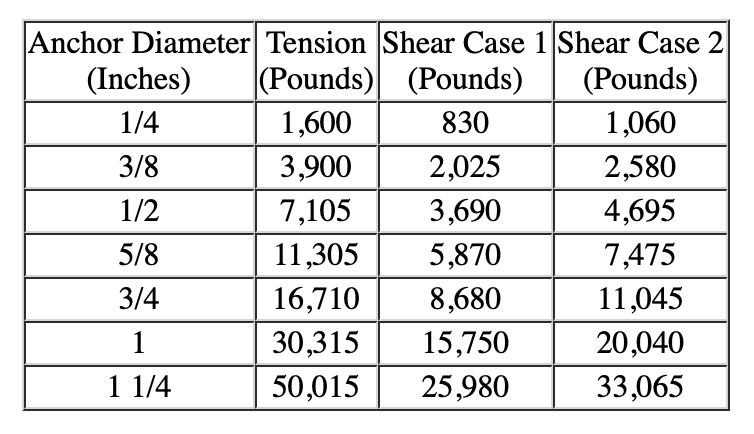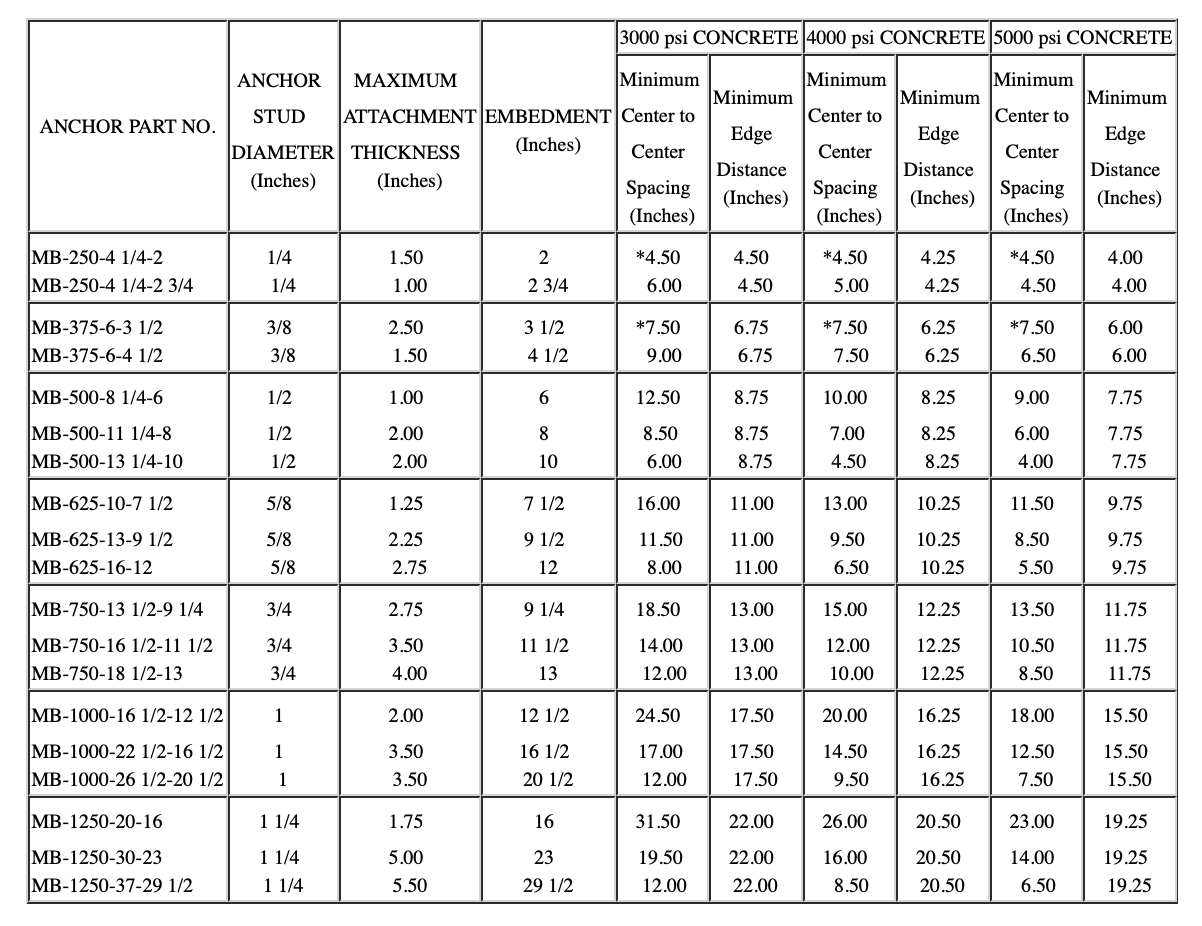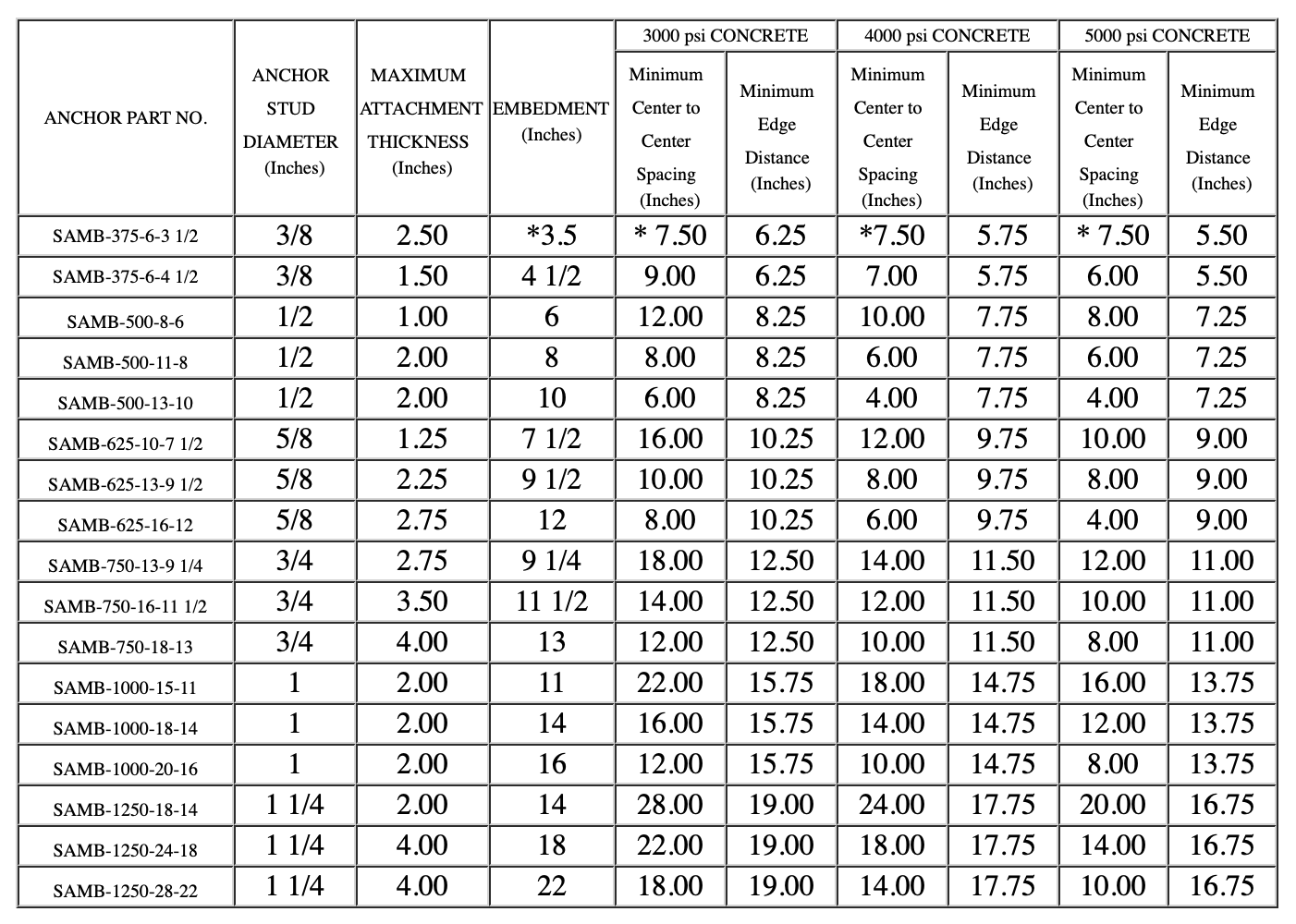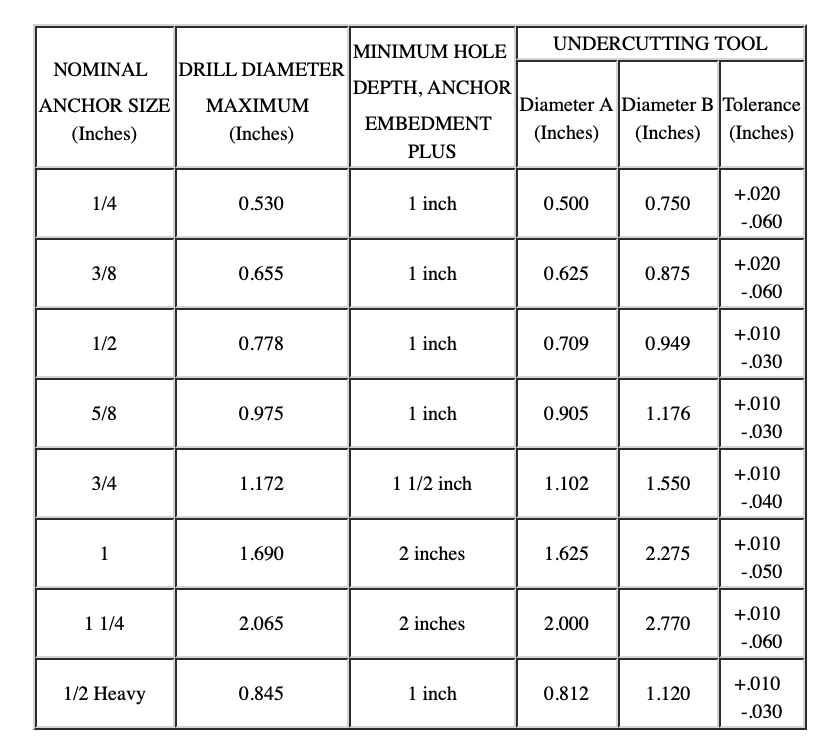Tension and Shear Allowable Load Tables / Embedment and Center to Center Spacing Tables and Tool Dimension & Tolerance Table for Drillco Maxi-Bolt Anchors
Notice: Unless otherwise noted, all load and design values presented herein are based on the provisions of ACI 349-97 or earlier. Design guidance based on ACI 318-05 and ACI 349-06 is being prepared and will appear here shortly. In the mean time you may wish to review the results of cracked concrete testing performed in accordance with ACI 355.2 as called for in the new codes.
Tension and Shear Allowable Load Tables
The following tables give tension and shear working stress design load allowables. These loads were calculated by reducing the ultimate strength design method values for each material type by a factor of 1.7. You may therefore increase these load allowables by 1.7 if you are employing ultimate strength design.
Load Allowables for A193 Grade B7 Material
Load Allowables for A36 Material
Load Allowables for A193 B8 (Type 304) and B8M (Type 316) - Class 1 Stainless Steel Material
Load Allowables for A193 B8 (Type 304) - Class 2 Stainless Steel Material
Load Allowables for A193 B8M (Type 316) - Class 2 Stainless Steel Material
Embedment, Edge Distance and Center to Center Spacing Tables
The following tables give embedment, edge distance and center to center spacing values for the various material types.
Embedment and Spacing for A193 Grade B7 Material
Embedment and Spacing for A36 Material
Embedment and Spacing for A193 B8 (Type 304) and B8M (Type 316) - Class 1 Stainless Steel Material
Embedment and Spacing for A193 B8 (Type 304) - Class 2 Stainless Steel Material
Embedment and Spacing for A193 B8M (Type 316) - Class 2 Stainless Steel Material
Tool Dimentsion and Tolerance Table
Maxi-Bolts of all material types utilize identical tooling diameters and tolerances. They are given in the following table.
Allowable Loads For Drillco Maxi-Bolts with ASTM A193 Grade B7 Stud Bolts

Notes
1. Shear Case 1 applicable for grouted plates. Shear Case 2 applicable for plates in contact with concrete surface.
2. Use straight line interaction for combined tension and shear loading.
3. All load allowables are premised on the concrete's ability to develop 100 percent of the stud bolt's minimum ultimate capacity. Applicable code provisions should be employed to determine the design strength of overlying concrete for particular anchor spacing and embedment combinations. Since most codes base the design strength of concrete on the combined projected areas of all bolts in a given pattern, Drillco has provided a Projected Concrete Area Calculator to assist in concrete strength calculations. Note that codes differ on the question of permitting reduced load allowables in cases where the design strength of concrete is less than the bolt's specified minimum ultimate strength.
4. The allowable loads noted in the above table may be assigned to each anchor in a multiple-anchor attachment. A single anchor used to anchor an attachment shall be designed for one half of the allowable loads noted. A single anchor is considered to be an anchor with no capability to redistribute its load to adjacent anchors.
Embedment and Center-to-Center Spacing Requirements for Drillco Maxi-Bolts with ASTM A193 Grade B7 Stud Bolts with up to six bolts in a rectangular pattern

*Recommendation based on independent laboratory testing. All other embedment and center to center recommendations based on design by analysis provisions of ACI 349. Appendix B.
NOTES:
1. Maximum attachment thickness is based on torque tensioning of anchor. Any lesser attachment thickness may be used. Where the anchor is to be hydraulically tensioned, maximum attachment thicknesses will be reduced by one stud diameter.
2. Consideration of stress area reduction for limited concrete depth is not reflected in the above table. Minimum concrete depth = anchor embedment plus (center-to-center spacing/2).
3. Maxi-Bolt part numbers are specified as follows: MB-Diameter Series Number --- Overall Length-Sleeve Length (combined expansion sleeve and distance tube lengths).
4. Minimum edge distances quoted are for shear or combined tension and shear. For tension loading, edge distance may be reduced to 75 percent of given value.
5. Allowable values are limited to a maximum of six bolts in a two-row, three-column, or three-row, two-column arrangement. Allowable values may also be used for anchors placed in a single line and separated from other anchor lines by a minimum distance of two times the anchor embedment length.
6. In-place embedment length is determined by subtracting the over-all length (second number shown in Anchor Part No. column) from the exposed projection.
Allowable Loads For Drillco Maxi-Bolts with ASTM A36 Stud Bolts

NOTES:
1. Shear Case 1 applicable for grouted plates. Shear Case 2 applicable for plates in contact with concrete surface.
2. Use straight line interaction for combined tension and shear loading.
3. All load allowables are premised on the concrete's ability to develop 100 percent of the stud bolt's minimum ultimate capacity. Applicable code provisions should be employed to determine the design strength of overlying concrete for particular anchor spacing and embedment combinations. Since most codes base the design strength of concrete on the combined projected areas of all bolts in a given pattern, Drillco has provided a Projected Concrete Area Calculator to assist in concrete strength calculations. Note that codes differ on the question of permitting reduced load allowables in cases where the design strength of concrete is less than the bolt's specified minimum ultimate strength.
4. The allowable loads noted in the above table may be assigned to each anchor in a multiple-anchor attachment. A single anchor used to anchor an attachment shall be designed for one half of the allowable loads noted. A single anchor is considered to be an anchor with no capability to redistribute its load to adjacent anchors.
Embedment and Center-to-Center Spacing Requirements for Drillco Maxi-Bolts with ASTM A36 Stud Bolts with up to six bolts in a rectangular pattern

*Recommendation based on independent laboratory testing. All other embedment and center to center recommendations based on design by analysis provisions of ACI 349. Appendix B.
NOTES:
1. Maximum attachment thickness is based on torque tensioning of anchor. Any lesser attachment thickness may be used. Where the anchor is to be hydraulically tensioned, maximum attachment thicknesses will be reduced by one stud diameter.
2. Consideration of stress area reduction for limited concrete depth is not reflected in the above table. Minimum concrete depth = anchor embedment plus (center-to-center spacing/2).
3. Maxi-Bolt part numbers are specified as follows: MB-Diameter Series Number --- Overall Length-Sleeve Length (combined expansion sleeve and distance tube lengths).
4. Minimum edge distances quoted are for shear or combined tension and shear. For tension loading, edge distance may be reduced to 75 percent of given value.
5. Allowable values are limited to a maximum of six bolts in a two-row, three-column, or three-row, two-column arrangement. Allowable values may also be used for anchors placed in a single line and separated from other anchor lines by a minimum distance of two times the anchor embedment length.
6. In-place embedment length is determined by subtracting the over-all length (second number shown in Anchor Part No. column) from the exposed projection.
Allowable Loads For Drillco Maxi-Bolts with ASTM A193 Grade B8 (Type 304) and B8M (Type 316) Class 1 Stainless Stud Bolts

NOTES:
1. Shear Case 1 applicable for grouted plates. Shear Case 2 applicable for plates in contact with concrete surface.
2. Use straight line interaction for combined tension and shear loading.
3. All load allowables are premised on the concrete's ability to develop 100 percent of the stud bolt's minimum ultimate capacity. Applicable code provisions should be employed to determine the design strength of overlying concrete for particular anchor spacing and embedment combinations. Since most codes base the design strength of concrete on the combined projected areas of all bolts in a given pattern, Drillco has provided a Projected Concrete Area Calculator to assist in concrete strength calculations. Note that codes differ on the question of permitting reduced load allowables in cases where the design strength of concrete is less than the bolt's specified minimum ultimate strength.
4. The allowable loads noted in the above table may be assigned to each anchor in a multiple-anchor attachment. A single anchor used to anchor an attachment shall be designed for one half of the allowable loads noted. A single anchor is considered to be an anchor with no capability to redistribute its load to adjacent anchors.
Embedment and Center-to-Center Spacing Requirements for Drillco Maxi-Bolts with ASTM A193 Grade B8 (Type 304) and B8M (Type 316) Class 1 Stainless Stud Bolts with up to six bolts in a rectangular pattern

*Recommendation based on independent laboratory testing. All other embedment and center to center recommendations based on design by analysis provisions of ACI 349. Appendix B.
NOTES:
1. Maximum attachment thickness is based on torque tensioning of anchor. Any lesser attachment thickness may be used. Where the anchor is to be hydraulically tensioned, maximum attachment thicknesses will be reduced by one stud diameter.
2. Consideration of stress area reduction for limited concrete depth is not reflected in the above table. Minimum concrete depth = anchor embedment plus (center-to-center spacing/2).
3. Maxi-Bolt part numbers are specified as follows: MB-Diameter Series Number --- Overall Length-Sleeve Length (combined expansion sleeve and distance tube lengths).
4. Minimum edge distances quoted are for shear or combined tension and shear. For tension loading, edge distance may be reduced to 75 percent of given value.
5. Allowable values are limited to a maximum of six bolts in a two-row, three-column, or three-row, two-column arrangement. Allowable values may also be used for anchors placed in a single line and separated from other anchor lines by a minimum distance of two times the anchor embedment length.
6. In-place embedment length is determined by subtracting the over-all length (second number shown in Anchor Part No. column) from the exposed projection.
Allowable Loads For Drillco Maxi-Bolts with ASTM A193 Grade B8 (Type 304) Class 2 Stainless Stud Bolts

NOTES:
1. Shear Case 1 applicable for grouted plates. Shear Case 2 applicable for plates in contact with concrete surface.
2. Use straight line interaction for combined tension and shear loading.
3. All load allowables are premised on the concrete's ability to develop 100 percent of the stud bolt's minimum ultimate capacity. Applicable code provisions should be employed to determine the design strength of overlying concrete for particular anchor spacing and embedment combinations. Since most codes base the design strength of concrete on the combined projected areas of all bolts in a given pattern, Drillco has provided a Projected Concrete Area Calculator to assist in concrete strength calculations. Note that codes differ on the question of permitting reduced load allowables in cases where the design strength of concrete is less than the bolt's specified minimum ultimate strength.
4. The allowable loads noted in the above table may be assigned to each anchor in a multiple-anchor attachment. A single anchor used to anchor an attachment shall be designed for one half of the allowable loads noted. A single anchor is considered to be an anchor with no capability to redistribute its load to adjacent anchors.
Embedment and Center-to-Center Spacing Requirements for Drillco Maxi-Bolts with ASTM A193 Grade B8 (Type 304) Class 2 Stainless Stud Bolts with up to six bolts in a rectangular pattern

*Recommendation based on independent laboratory testing. All other embedment and center to center recommendations based on design by analysis provisions of ACI 349. Appendix B.
NOTES:
1. Maximum attachment thickness is based on torque tensioning of anchor. Any lesser attachment thickness may be used. Where the anchor is to be hydraulically tensioned, maximum attachment thicknesses will be reduced by one stud diameter.
2. Consideration of stress area reduction for limited concrete depth is not reflected in the above table. Minimum concrete depth = anchor embedment plus (center-to-center spacing/2).
3. Maxi-Bolt part numbers are specified as follows: MB-Diameter Series Number --- Overall Length-Sleeve Length (combined expansion sleeve and distance tube lengths).
4. Minimum edge distances quoted are for shear or combined tension and shear. For tension loading, edge distance may be reduced to 75 percent of given value.
5. Allowable values are limited to a maximum of six bolts in a two-row, three-column, or three-row, two-column arrangement. Allowable values may also be used for anchors placed in a single line and separated from other anchor lines by a minimum distance of two times the anchor embedment length.
6. In-place embedment length is determined by subtracting the over-all length (second number shown in Anchor Part No. column) from the exposed projection.
Allowable Loads For Drillco Maxi-Bolts with ASTM A193 Grade B8M (Type 316) Class 2 Stainless Stud Bolts

NOTES:
1. Shear Case 1 applicable for grouted plates. Shear Case 2 applicable for plates in contact with concrete surface.
2. Use straight line interaction for combined tension and shear loading.
3. All load allowables are premised on the concrete's ability to develop 100 percent of the stud bolt's minimum ultimate capacity. Applicable code provisions should be employed to determine the design strength of overlying concrete for particular anchor spacing and embedment combinations. Since most codes base the design strength of concrete on the combined projected areas of all bolts in a given pattern, Drillco has provided a Projected Concrete Area Calculator to assist in concrete strength calculations. Note that codes differ on the question of permitting reduced load allowables in cases where the design strength of concrete is less than the bolt's specified minimum ultimate strength.
4. The allowable loads noted in the above table may be assigned to each anchor in a multiple-anchor attachment. A single anchor used to anchor an attachment shall be designed for one half of the allowable loads noted. A single anchor is considered to be an anchor with no capability to redistribute its load to adjacent anchors.
Embedment and Center-to-Center Spacing Requirements for Drillco Maxi-Bolts with ASTM A193 Grade B8M (Type 316) Class 2 Stainless Stud Bolts with up to six bolts in a rectangular pattern

*Recommendation based on independent laboratory testing. All other embedment and center to center recommendations based on design by analysis provisions of ACI 349. Appendix B.
NOTES:
1. Maximum attachment thickness is based on torque tensioning of anchor. Any lesser attachment thickness may be used. Where the anchor is to be hydraulically tensioned, maximum attachment thicknesses will be reduced by one stud diameter.
2. Consideration of stress area reduction for limited concrete depth is not reflected in the above table. Minimum concrete depth = anchor embedment plus (center-to-center spacing/2).
3. Maxi-Bolt part numbers are specified as follows: MB-Diameter Series Number --- Overall Length-Sleeve Length (combined expansion sleeve and distance tube lengths).
4. Minimum edge distances quoted are for shear or combined tension and shear. For tension loading, edge distance may be reduced to 75 percent of given value.
5. Allowable values are limited to a maximum of six bolts in a two-row, three-column, or three-row, two-column arrangement. Allowable values may also be used for anchors placed in a single line and separated from other anchor lines by a minimum distance of two times the anchor embedment length.
6. In-place embedment length is determined by subtracting the over-all length (second number shown in Anchor Part No. column) from the exposed projection.
Dimensions and Tolerances for Drill Bits and Undercutting Tools Used to Install Drillco Maxi-Bolts

NOTES:
1. Undercutting tool diameter A is given for identification purposes only. No tolerance applies to this dimension.
2. Undercutting tool diameters A and B are noted in Figure No. 3.
